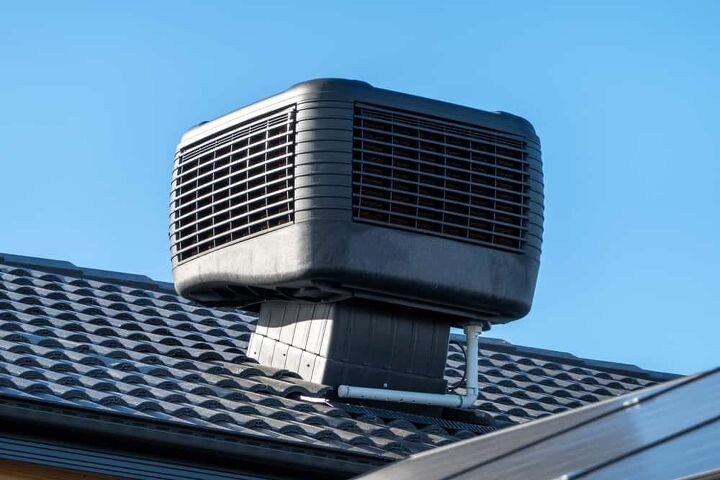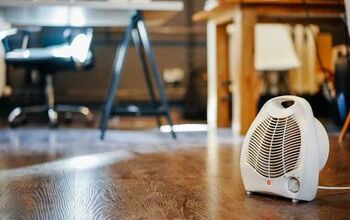Swamp Cooler Motor Keeps Shutting Off? (We Have a Fix!)

Swamp coolers are great options to consider if your household is struggling against the oppressive heat. They can be a terrific addition to your home under the right circumstances. But in the middle of summer, one of the worst things is when your swamp cooler motor keeps shutting off.
Your swamp cooler motor keeps shutting off when it overheats from poor lubrication, faulty wiring, poor belt tension, or using the incorrect voltage. A poorly located or faulty thermostat can also cause your swamp cooler to overheat and shut down constantly. Check your swamp cooler manual for the proper voltage and maintain your cooler correctly; if it’s malfunctioning have a professional inspect it.
You can even swap out your costly air conditioner for a swamp cooler and still experience great comfort during the summer. Still, swamp coolers can present problems of their own. Figure out what’s wrong with it and how you can address the issue by continuing with this article.
Do You Need Swamp Cooler Repair or Service?
Get free, zero-commitment quotes from pro contractors near you.

What Is a Swamp Cooler?
Swamp coolers, which are also known as evaporative coolers, have been around for a while now. Despite that, they always seem to be in the shadow of the more ubiquitous air conditioners.
Note that evaporative coolers are often cheaper than air conditioners to both install and operate. The Department of Energy notes that installing a swamp cooler costs half as much as adding an air conditioner. Furthermore, swamp coolers only consume about a quarter of the energy that air conditioners do, meaning the savings are very real.
If you’re looking for a more cost-effective way of cooling your home, they could be your best option. Still, they do have drawbacks too. Most notably, swamp coolers are not suitable to be used in all areas. They struggle especially in areas where there’s plenty of humidity.
It’s one of the reasons why overheating is such a common problem for swamp coolers and we’ll get to that later.
How Do Swamp Coolers Work?
Found inside an evaporative cooler are components such as a motor, a wetted mat, a pump, and a belt-driven fan. The pump is responsible for keeping the mat hydrated while the motor works to turn the fan constantly. The fan then sucks the evaporated air from the mat and pushes that into your air.
Since the evaporated air is likely cooler than the stagnant air in your home, you’ll experience better cooling. The process itself is simple, but it yields highly effective results.
The Reasons Swamp Coolers Overheat and How to Address Them
Given the simplicity of the swamp cooler’s operation, you can see why one component having trouble bogs the whole thing down. More often than not, it’s the motor that becomes problematic, with overheating likely being the issue.
You should know that there are different possible explanations for an overheating swamp cooler motor. We’ve highlighted them below along with the possible fixes you can try.
Issue 1: The Swamp Cooler Is Not Running at the Right Voltage
Sometimes, your excitement can really get the better of you. Because you’re so excited to get your evaporative cooler up and running, you may have overlooked something important. More specifically, you may have overlooked the recommended voltage for the cooler.
If the amount of voltage used to run the cooler is too high, its internal components could get damaged. The wiring could start to fry and the motor will almost certainly overheat.
Compounding the issue here is that the evaporative cooler will still run even if the voltage is too high. You may not think that something’s wrong because the cooler is still working.
The FixCheck out the swamp cooler’s manual and look for its recommended voltage. The recommended voltage should also be indicated on the cooler itself.
Once you’ve determined the appropriate voltage, make adjustments as necessary. This could lead to you moving the swamp cooler, but that’s better than having the internal components potentially catch fire.
Issue 2: Faulty Electrical Connections
Incorrect voltage is not the only electrical problem that could plague your swamp cooler. The wires, switches, and fuses inside the cooler could be problematic as well. Some of those components could be connected incorrectly and that could lead to the motor overheating.
The FixThis kind of issue is pretty rare and likely has something to do with manufacturer error if the cooler is new. Contact them about the problem and seek a potential replacement. If the wires have frayed over time, poor maintenance could be the culprit. You could get the unit rewired by an electrician or opt to replace it completely.
Issue 3: The Belt Is Not Configured Properly
Another potential explanation for the overheating motor in your swamp cooler is the belt not being configured correctly. As we noted earlier, the motor operates the belt-driven fan. When that belt is not on the right way, the fan will not work too, causing the motor to overheat.
The FixA belt that’s either too tight or too loose can be problematic for the evaporative cooler. Grab an Allen wrench and work to correct that. Adjust the belt to the point where you’re only getting an inch of play as that will ensure proper operation.
Issue 4: The Shaft Bearings Are Poorly Lubricated
Helping the motor inside your swamp cooler work correctly are two shaft bearings. Those shaft bearings have to move around a lot inside the swamp cooler, which is why they have to be lubricated.
If the shaft bearings are not adequately lubricated, they have a tendency to stop moving. Once they stop moving, your motor is going to suffer from overheating relatively soon.
The FixTry to ascertain what kind of shaft bearings are used in your swamp cooler and look them up online. That should tell you how they need to be lubricated.
Be careful not to go overboard with the lubrication. Excessive lubrication can cause problems too as the shaft bearings may move around too much. Overheating could also be the end result of excessively lubricating the shaft bearings in your swamp cooler.
What Are the Differences between Air Conditioners and Swamp Coolers?
While both air conditioners and swamp coolers are supposed to make homes more comfortable, they go about it in different ways. We’ve already touched on how swamp coolers can be the more cost-effective option, but that’s not the only notable dissimilarity.
If you’re using an air conditioner, you have to keep your home or room closed. Leaving a door or window open will lead to cold air escaping and the room’s temperature rising. Swamp coolers are more flexible in that regard because they can work just fine with the windows open.
Swamp Coolers vs. Air Conditioners Explained
The way the two machines operate differ. Swamp coolers rely on air, a fan, and evaporated water to help cool down your home. On the other hand, air conditioners cycle air continuously through coils containing a special refrigerant to provide cooling.
Because of the disparity in operation, air conditioners and swamp coolers also vary in terms of usefulness. Air conditioners are suitable to be used just about anywhere. It doesn’t matter where in the country you live, an air conditioner will be a positive addition to your home.
Swamp coolers can also be used all over the country. However, that assumes that you’re using them outdoors or in spaces with wide openings such as garages. Swamp coolers struggle more indoors.
They can only work effectively indoors in dry environments. If you use them indoors in a humid place, they won’t work as intended.
How Are Swamp Coolers Maintained?
Just as with air conditioners, proper maintenance is an important aspect of swamp cooler ownership. You can really cut down on the longevity of your evaporative cooler by neglecting simple maintenance.
There are two different aspects of swamp cooler maintenance. First, you have major maintenance. This is when you have to open up the swamp cooler and clean it thoroughly. Get rid of debris that has accumulated on the swamp cooler because those can cause damage in the long run.
This is also the time during which you should check up on the cooler’s internal components. We already talked about how damaging it can be to the cooler if its components are not working as intended. Use this time to check on the belt, bearings, and any other components inside the machine.
Consider calling over the professionals if you’re not used to maintaining your evaporative cooler just yet.
Maintenance Takes Time
The more routine maintenance is pretty involved too. You will have to clean up the filters, pads, and reservoirs on the cooler at least once a month. Clean them less frequently than that and the performance of the entire unit will be affected.
You should refer to the swamp cooler’s manual before cleaning the pads. The manufacturer will usually indicate which substances should be used for cleaning them so follow their directions.
The pads are also not supposed to be used for a long time. Over the course of one summer, you may have to replace them multiple times. How often you have to replace the pads will depend on how often you use the cooler.
There’s no denying that swamp cooler maintenance can be labor-intensive. Swamp coolers can still be worth that effort given their cost-effective cooling.
Do You Need Swamp Cooler Repair or Service?
Get free, zero-commitment quotes from pro contractors near you.

Related Questions
How Long Do Swamp Coolers Last?
Assuming proper maintenance, your swamp cooler could last for well over 20 years. In this case, proper maintenance means conducting major cleaning and continually checking on the cooler even when it’s not in use.
When Is the Best Time to Run Your Swamp Cooler?
If you’re looking to maximize the comfort you’re getting from the swamp cooler, turning it on at night would be ideal. The cooler air will flow more effectively throughout your home. Running the cooler early in the morning and during the evening will also result in improved comfort.
Should You Put Ice in the Swamp Cooler if You Want Colder Air?
According to Newair, the cold blast offered by ice when it’s placed inside an evaporative cooler is only temporary. That’s because adding the ice won’t do much to remove heat from the air.For homeowners looking to cool down their homes better, Newair suggests placing room temperature water in the cooler instead.

We are a team of passionate homeowners, home improvement pros, and DIY enthusiasts who enjoy sharing home improvement, housekeeping, decorating, and more with other homeowners! Whether you're looking for a step-by-step guide on fixing an appliance or the cost of installing a fence, we've here to help.
More by Upgraded Home Team











![The 5 Best Angle Grinders – [2022 Reviews & Buyer's Guide]](https://cdn-fastly.upgradedhome.com/media/2023/07/31/9071326/the-5-best-angle-grinders-2022-reviews-buyer-s-guide.jpg?size=350x220)
![Finishing Basement Without Permit [Is It Really Illegal?]](https://cdn-fastly.upgradedhome.com/media/2023/07/31/9070078/finishing-basement-without-permit-is-it-really-illegal.jpg?size=350x220)














